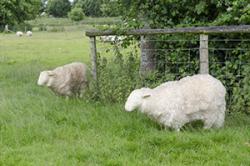Model ‘Electric’ Sheep Helping Researchers Keep Flocks in Fine Fettle
 Multiland Sheep: Photo: WTML\Laurence Clark Have you ever thought how a sheep feels when it’s freezing cold or baking hot? And whether an animal’s reaction to the weather affects farm productivity?
Multiland Sheep: Photo: WTML\Laurence Clark Have you ever thought how a sheep feels when it’s freezing cold or baking hot? And whether an animal’s reaction to the weather affects farm productivity?
Two ewes in the fields of north Wales are helping find the answers. From a distance they look much like other sheep; but their thick fleeces, ear tags and woolly tails hide a hi-tech secret.
They are ‘electric’ sheep, life like models, with a special battery operated heating system which simulates the heat produced by a live animal. Researchers are using them to measure the effectiveness of trees and shelter belts to protect flocks from adverse weather.
PhD student Pip Jones takes the model ewes’ temperatures as she moves them around the fields at Bangor University’s research farm; comparing what happens in places where trees, hedgerows or shelter belts offer protection, against locations where there’s no shelter.
Wind flow and microclimate around hedgerows are being measured by Pip’s colleague Yufeng He.
Pip Jones said:
“We’re looking at how weather is experienced on a ‘sheep scale’ and although it’s early days I’ve been really surprised by some measurements. Sheep use a substantial amount of energy just staying warm; and lose a lot of heat when it’s cool, especially when there’s a wind chill.
“On a hot day when the weather was around 30C at the study site, we put a model sheep in direct sun, and the fleece recorded a temperature of 60C, which is incredibly hot. This is where the shelter of trees could really contribute, creating shade in the summer and reducing the effects of wind-chill in winter.”
Dr. Andy Smith, Senior Lecturer in Forestry at Bangor University’s School of Environment, Natural Resources & Geography said:
“If it’s very cold a sheep burns more energy to keep warm for survival and it needs more food. Conversely if it’s too hot, animals tend to eat less and seek shade to keep cool. Both situations affect weight gain and productivity because energy that could go into growth is used to regulate metabolism instead.”
Heating elements and thermostats inside the models mimic heat produced by a live sheep’s metabolism. By measuring the difference between internal and external temperature, researchers can work out how much energy the sheep loses just trying to deal with the weather. So far the team has worked out that over the three months of winter, if it averaged a chilly 6C outside, 100 sheep would need to graze one eighth of a hectare of early spring grass just to produce the energy they needed to keep warm, energy that is therefore not available for growth.
Pip Jones added:
"Tree-shelter from chilling wind could save energy and provide a real efficiency boost in the conversion of energy eaten to actual growth and health in our young livestock."
Exposure to cold winds can exacerbate flock welfare issues. Outdoor lambing and early turnout of young lambs into fields increases the importance of shelter. Shelterbelts have potential benefits for reducing the risk of hypothermia in new born lambs, and mastitis in ewes. Planting trees and hedgerows can improve drainage, and provides an opportunity to fence off trees to divert sheep away from wet areas where fluke thrives.
The eventual aim of the research is to produce a practical tool kit for farmers to show them the best places to plant for effective shelter and shade.
The model sheep were showcased at NSA 2016, the National Sheep Association’s show at Malvern.
The study is part of Multi-Land a research partnership finding ways to increase farm profitability and efficiency through sustainable agriculture, whilst improving resilience of the farmland landscape. Pip's research, into the potential for tree shelter systems to save the energy and lives of livestock in adverse weather, is funded through the KESS scholarship in partnership with the Woodland Trust.
Helen Chesshire, the Woodland Trust’s senior farming advisor said:
“Our advisors have years of experience, we can provide subsidised trees, on-farm assessments and bespoke planting schemes.”
To find out more about how we can help you to plant trees on your farm call 0330 333 5303 or email plant@woodlandtrust.org.uk
Publication date: 1 September 2016
